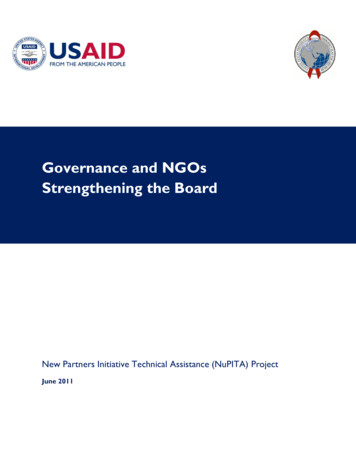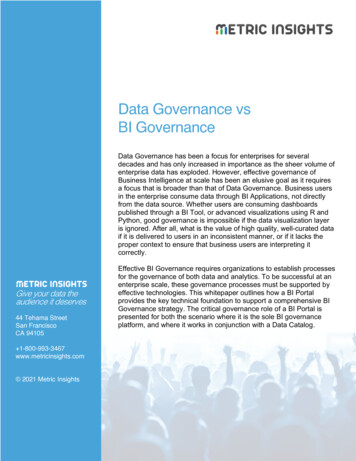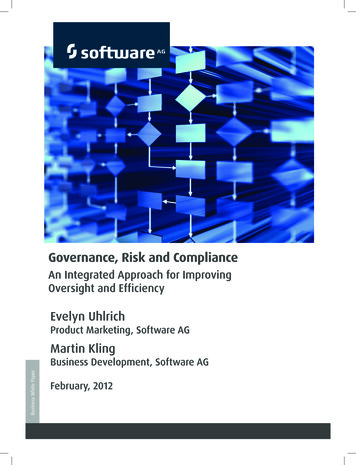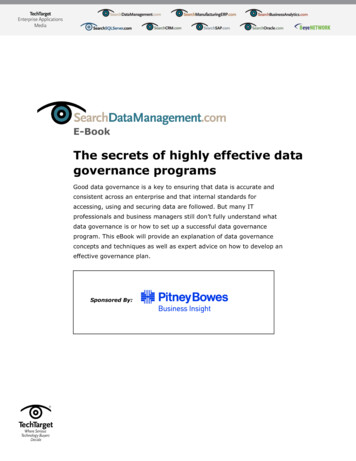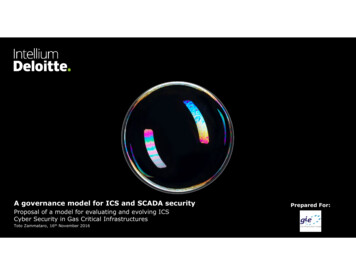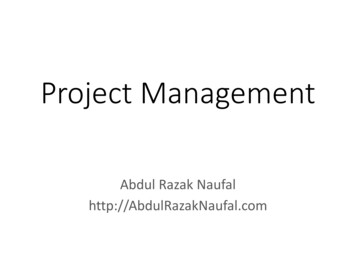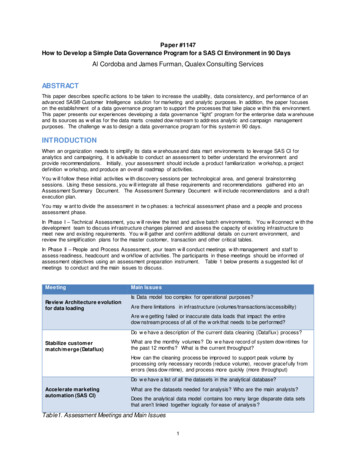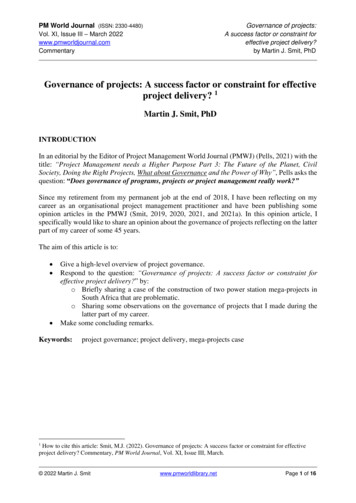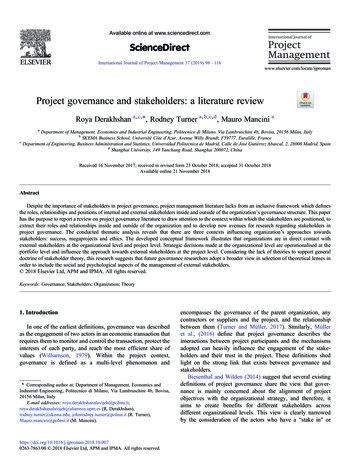
Transcription
Available online at www.sciencedirect.comScienceDirectInternational Journal of Project Management 37 (2019) 98 – 116www.elsevier.com/locate/ijpromanProject governance and stakeholders: a literature reviewRoya Derakhshan a,c,⁎, Rodney Turner a,b,c,d , Mauro Mancini aacDepartment of Management, Economics and Industrial Engineering, Politecnico di Milano, Via Lambruschini 4b, Bovisa, 20156 Milan, ItalybSKEMA Business School, Université Côte d’Azur, Avenue Willy Brandt, F59777, Euralille, FranceDepartment of Engineering, Business Administration and Statistics, Universidad Politecnica de Madrid, Calle de José Gutiérrez Abascal, 2, 28006 Madrid, SpaindShanghai University, 149 Yanchang Road, Shanghai 200072, ChinaReceived 16 November 2017; received in revised form 23 October 2018; accepted 31 October 2018Available online 21 November 2018AbstractDespite the importance of stakeholders in project governance, project management literature lacks from an inclusive framework which definesthe roles, relationships and positions of internal and external stakeholders inside and outside of the organization's governance structure. This paperhas the purpose to report a review on project governance literature to draw attention to the context within which the stakeholders are positioned, toextract their roles and relationships inside and outside of the organization and to develop new avenues for research regarding stakeholders inproject governance. The conducted thematic analysis reveals that there are three contexts influencing organization's approaches towardsstakeholders: success, megaprojects and ethics. The developed conceptual framework illustrates that organizations are in direct contact withexternal stakeholders at the organizational level and project level. Strategic decisions made at the organizational level are operationalised at theportfolio level and influence the approach towards external stakeholders at the project level. Considering the lack of theories to support generaldoctrine of stakeholder theory, this research suggests that future governance researchers adopt a broader view in selection of theoretical lenses inorder to include the social and psychological aspects of the management of external stakeholders. 2018 Elsevier Ltd, APM and IPMA. All rights reserved.Keywords: Governance; Stakeholders; Organization; Theory1. IntroductionIn one of the earliest definitions, governance was describedas the engagement of two actors in an economic transaction thatrequires them to monitor and control the transaction, protect theinterests of each party, and reach the most efficient share ofvalues (Williamson, 1979). Within the project context,governance is defined as a multi-level phenomenon and⁎ Corresponding author at: Department of Management, Economics andIndustrial Engineering, Politecnico di Milano, Via Lambruschini 4b, Bovisa,20156 Milan, ItalyE-mail addresses: lavijeh@alumnos.upm.es (R. Derakhshan),rodney.turner@skema.edu; johnrodney.turner@polimi.it (R. Turner),Mauro.mancini@polimi.it (M. 0.0070263-7863/00 2018 Elsevier Ltd, APM and IPMA. All rights reserved.encompasses the governance of the parent organization, anycontractors or suppliers and the project, and the relationshipbetween them (Turner and Müller, 2017). Similarly, Mülleret al., (2016) define that project governance describes theinteractions between project participants and the mechanismsadopted can heavily influence the engagement of the stakeholders and their trust in the project. These definitions shedlight on the strong link that exists between governance andstakeholders.Biesenthal and Wilden (2014) suggest that several existingdefinitions of project governance share the view that governance is mainly concerned about the alignment of projectobjectives with the organizational strategy, and therefore, itaims to create benefits for different stakeholders acrossdifferent organizational levels. This view is clearly narrowedby the consideration of the actors who have a “stake in” or
R. Derakhshan et al. / International Journal of Project Management 37 (2019) 98–11699Table 1Summary of dominant governance theories, their application in project management and their position towards stakeholders.TheoryGeneral Focus in the TheoryAgency theoryDiscussing the relationships between theprincipal and agent in the organizations withself-interested manners, different risk attitudeand levels of authority (Mitnick, 1973; Ross,1973; Eisenhardt, 1989)Transaction cost onal costs during outsourcing goodsand services (Williamson, eholdertheoryExpressing that managers are motivated better byorganizational objectives compared to theirpersonal interests and long-term performance ofthe organization would boost their position(Donaldson and Davis, 1991; Davis et al., 1997)Defining how organizational resources should beallocated in order to achieve the corporateobjectives (Pfeffer and Salancik, 1978)Clarifying that apart from shareholders, whoeveris influencing or being influenced by theorganization should be taken into account(Freeman, 1984)Main application of theory in projectmanagementTheory's position towards stakeholdersDescribing the relationship between the projectowner and manager, monitoring andcontrolling the manager's behavior based ontrust or control and punishment (Turner et al.,2010; Zwikael and Smyrk, 2015)Decision about selection of contractors andsuppliers (Turner and Keegan, 2001; Williamset al., 2006; Müller and Martinsuo, 2015)Focusing on relationships between twoimportant internal stakeholders and theinfluence of this relationship on the projectperformance with an emphasize on trustProviding tools for decision makers toprioritize the allocation of resources fordifferent individual projects (Thompson, 2011)Defining who are the stakeholders whoseconcerns should be considered in projectstakeholder management (Blomquist andMüller, 2006; Xie et al., 2017)Works as a tool to operationalise stakeholderpreferences of the organizationDefinition of roles and responsibilities ofprojects and external stakeholders with afocus on economic aspects (contractors andsuppliers)Application for project and program managers Focusing on the relationship between twowho act as the best interest of their principals internal stakeholders with an emphasize on the(project sponsors) (Turner and Keegan, 2001; organization's long-term performance, trustToivonen and Toivonen, 2014).building and mutual value creation“interest in” the project as defined by Littau et al., (2010), orinternal stakeholders as labelled by Freeman (1984), thusoverlooking those who “can affect and be affected by” theproject (Littau et al., 2010) or external stakeholders (Freeman,1984).Therefore, it seems that the project governance literatureleaves the moral obligation of organization for considerationof rights and concerns of external stakeholders untouched(Freeman, 2001). If so, then there must be new avenues openfor further research in order to extend the project management literature towards a more stakeholder inclusive approach. In addition, despite the important role of stakeholdersin the organizations, project management literature lacks froma framework which defines the roles, relations and positionsof internal and external stakeholders in project governance.Accordingly, inspired by stakeholder theory, we take a biasedposition regarding the inclusion of external stakeholders andexplore the intersection between the two fields of stakeholders andproject governance. The specific aims of this paper are as follows:(1) to identify the main themes of project governance literature,focusing specifically on stakeholders. (2) To identify the roles andrelationships among internal and external stakeholders at differentlevels of the organization. (3) And finally to provide structure anddirection to the existing and future research.The next section of this paper will review the general projectgovernance theories and their perspective towards stakeholders.Then, the methodological approach taken for this paper will beexplained followed by presentation of the findings. We willfinally discuss the findings in the light of governance prevalenttheories and will introduce our developed conceptual framework. The article will be concluded by bringing the suggestionsfor future studies.Shedding light on consideration of thestakeholders outside the organization and theimportance of their position in theorganizational settings2. Stakeholders in governance theoriesA prerequisite for further investigation into the link betweengovernance and stakeholders is studying how stakeholders areconsidered in project governance dominant theories. Asummary of these theories with their application in projectgovernance is provided in Table 1. These theories areintroduced by Müller (2009) and Biesenthal and Wilden(2014). While these two sources bring extensive explanationsabout the origins of these theories and their application in thefields of management and project management, our aim here isto emphasize on the stakeholder perspective of these theories.(See Table 1.)Agency theory is used in the context of projectmanagement to explain the relationship between the projectowner and manager (Turner et al., 2010) or the principal andagent (as named by Jensen and Meckling (1976)). Müller(2009) explains that this theory relates to shareholder theoryby discussing the potential conflicts that may arise betweenthe project managers and shareholders. Agency theory dealswith the level of authority of the project managers (agents)and links that to the decision making and project managers'risk attitude (Eisenhardt, 1989). According to agency theory,project managers are responsible for decision making in theorganization on behalf of the shareholders or project owners.Accordingly, this theory discusses how short term goals ofthese principles (time and cost performance) can be achievedby development of controlling and monitoring mechanismswhich govern project managers' behavior. In projectmanagement literature, this theory gives a huge credit tothe value of contracts as controlling tools for governing theserelationships.
100R. Derakhshan et al. / International Journal of Project Management 37 (2019) 98–116Transaction cost economics (TCE) focuses on the relationship between the buyer and seller and has been used in theproject management context to describe the contractor andsupplier selection process (Winch, 2001). Considering the costsinvolved in transacting services and goods to anotherorganization, this theory argues how organizations make adecision about outsourcing in order to minimize the costs.Müller (2009) adds that this theory helps to align the needs ofprojects with the needs of contractors in specific governancestructures. To summarize, this theory brings guidelines forgoverning the contract with those stakeholders who are notinside the organization but have a financial transaction with it(i.e. suppliers and contractors).In stewardship theory, project managers are considered asstewards who believe that their ultimate position improves byimproving organizational performance (Turner and Keegan,2001; Müller et al., 2013a; Müller et al., 2014b). Thereforeaccording to stewardship theory, project managers are notnarrowed by their short-term beneficiary needs. Instead, it is thetrust in the project owners and the organizational aims whichshapes the project managers' behaviour (Davis et al., 1997).Project organizations, therefore, will be more successful insatisfying shareholders if they empower their stewards (i.e.project managers) (Biesenthal & Wilden, 2014; Joslin andMüller, 2016). stewardship theory is focusing on the impact ofproject managers on the corporate governance.Decision making about the allocation and prioritization ofthe external and internal resources of the organization shapesthe main part of resource dependence theory. In this theory,the ultimate success of the organization is considered to bestrongly dependent on the organization's ability to control itsinternal and external resources (Clarke, 2004). This theorycan explain how organizations can overcome their lifelongchallenges through appropriate allocation of resources andtherefore has both long term and short term targets. Potentialapplication of this theory in project context would becapturing the importance of decison making in allocation ofresources in different projects, portfolios and programs andtherefore this theory primarily relates to those stakeholderswho are decision makers at the portfolio level. It is thenlinked to those stakeholders whose benefits must beconsidered while the decision of buying is made (i.e.contractors and suppliers).In contrast to shareholder theory (Friedman, 1962), stakeholder theory (Freeman, 1984) argues that in addition to theshareholders, project organization is accountable to a broaderrange of stakeholders, and the structure of the organizationshould also be aligned with this inclusive approach. This in factstems from the normative formulation of stakeholder theorythat considers a moral right for all of the stakeholders of theorganization, inside and outside (Donaldson and Preston,1995). The governance structure of the project should providespace for stakeholder representatives and to manage theirinvolvements in decision making and addressing their concernsand demands (Klakegg et al., 2016).These theories are the prevalent governance theories, despitenot all of them have been vastly used in the projectmanagement context (Bisenthal & Wilden, 2014). Comparedto the other mentioned theories, agency theory, TCE andstewardship theories have been more used by project governance researchers. This, as the first indication, reveals howproject governance literature is influenced by dominantconcentration on the relationships between project managers,project owners and suppliers or contractors.Based on the approach these theories adopt towardsstakeholders, we can categorize them in two groups: thoseproject governance theories that manage the transactionsamong internal stakeholders (agency theory, stewardshiptheory, resource dependence theory) and those governing therelations among internal and external stakeholders (TCE,resource dependence theory and stakeholder theory).Revieweing the most prevalent theories in project governance literature reveales that the potential of these theories inproject governance literature is yet underexplored. Morespecifically, the inclusive approach of stakeholder theory, themulti-level nature of project governance and the impact ofproject context on the governance mechanisms (Turner et al.,2010; Söderlund, 2011) call for deeper explorations on theapplication of these theories in stakeholder management overdifferent levels of organization and within different projectcontexts.3. Method and overview3.1. Data collectionThis study is based on a review of the content of theresearch papers in project governance, to extract the majorresearch streams and to identify to what extent projectgovernance is relevant to the management of relationshipswith external stakeholders. The research focus is on studyingthe research outcomes, concentrating on the role ofstakeholders in the literature. The research goal is tosummarize and integrate the findings and to extract theresearch gaps and identify future research directions. We donot take a neutral perspective. Instead, we make oursuggestions for further research based on the perspectivetaken from stakeholder theory; the rights of externalstakeholders should be considered in projects deploymentby practitioners and the academic research, by academicians.The coverage of the research is representative by includingthree main project management journals that typify the largerliterature (Vom Brocke et al., 2009).The first stage of data collection is the selection of peerreviewed journals (Tranfield et al., 2003). The intent of thisresearch is to focus on the premier academic journals in thefield of project management, and the criteria for the inclusionand exclusion of the studied papers were based on high-qualityevidence which implies to internal and external validity of theresearch items (Moher et al., 2009; Webster and Watson, 2002).According to Rowley and Slack (2004), articles withinscholarly journals are the most valid sources for a literaturereview. Thus, following Martinsuo and Hoverfält (2018) welimited the search to the three main journals in project
R. Derakhshan et al. / International Journal of Project Management 37 (2019) 98–116management: International Journal of Project Management(IJPM), Project Management Journal (PMJ) and InternationalJournal of Managing Projects in Business (IJMPiB).The second stage was identifying the keywords for theresearch objective (Mok et al., 2015). We searched for allarticles that have “project governance” and “governance ofproject management” in the title, abstract or as keywords. Wesearched for all articles from the first year of each journal'spublication until August 2017. We identified 89 articles inIJPM, 15 in PMJ and 28 in IJMPiB. This is consistent with thefindings of Miterev et al., (2016) that IJPM deals more withstrategic issues than either of the other two journals.Finally we conducted a review of the content of each paper(Mok et al., 2015). The inclusion and exclusion stage isrelatively subjective (Tranfield et al., 2003). To enhanceobjectivity and avoid mistakes in study selection, the processwas performed independently in a standardized manner by twoauthors (Moher et al., 2009). Disagreements between authorswere resolved by consensus involving the third author. Wereviewed the abstracts of the papers to determine those articlesfor which the governance of project management was the keyfocus, as opposed to those where it was a topic of secondaryimportance supporting the main topic of the paper. This stagereduced the number of relevant articles to 59 from IJPM, 9 fromPMJ and 19 from IJMPiB, for a total of 87 papers.3.2. Data analysisThe analysis included two steps of identification of thecontext within which the project governance literature positionsthe stakeholders and extraction of the roles and relations withinthe organizational structure. In order to minimize bias, all threeauthors were independently involved in the process. After eachstep and before moving to the next one, the analysis resultswere compared together to reach agreements.Braun and Clarke (2012) developed a six-phase approach forthe thematic analysis. Adapted from this approach, we designedour inductive analysis (Fig. 1). We started by reading the 87articles over and over to identify our preliminary codes(Appendix A). The reading was driven by the objectives ofthe papers, their stated contributions and presented findings.The codes and their definition are presented in Appendix B. Wethen combined the codes to find the patterns in the articles (subthemes) through two subsequent steps. As it can be read fromAppendix A, there are codes which were combined to makedifferent sub-themes and therefore the final themes haveoverlaps with each other. This is also due to the consensusthe three authors made to agree on the final themes.There are 13 sub-themes presented at level 3 of the thematicanalysis, by combining which six themes emerged at level 2:governance mechanisms, success and value, megaproject andpublic projects, stakeholder management, knowledge andethics. Due to the considerable overlap of the themes at level2, we then merged the sub-themes of success, knowledge andgovernance mechanisms into one final theme (success) andstakeholders' sub-theme was merged with ethics so that weeventually came up with the final three themes: Success,101megaprojects, ethics. Appendix C illustrates the themes that arecovered within each paper in a matrix structure borrowed fromSalipante et al., (1982).To explore the roles and relationships among differentstakeholders in the project governance literature, we firstextracted the levels of the governance that each reviewed paperis focusing on. Some of the papers focus on more than onelevel. The reviews revealed that majority of papers have takenan inductive approach, while only few of them aim at testingtheories. We then identified all of the stakeholders which arestudied or mentioned in each reviewed article. We realized thatnot all papers acquire the similar approach in describing thesame stakeholders. Project managers, for instance, aredescribed as decision makers is some papers while other papersconsider them as responsible to implement organizationalstrategies to create values. This is dependent to the type ofrelationships the paper is analyzing, in addition to the scope ofgovernance targeted by the paper.Müller (2009) suggests that the functions of the governancemechanisms are: directing and controlling the organization,balancing goals (economic, social, environmental, individual)and defining rights and responsibilities of stakeholders. Weused this classification as a framework for categorizing thestakeholders. We came up with a categorization which groupsstakeholders as decision makers or as origins and targets ofvalue.The two types of relations among stakeholders are adaptedfrom Turner and Keegan (2001) who stated that there are tworoles in project governance, one responsible for the relationshipwith the external stakeholders and the other focuses on therelationship between the parent organization and the projectteam.Appendix D illustrates the focus of governance of the 87papers. Figures in Appendix E reflect the fact that IJPM has amore strategic focus while PMJ has a tactical focus and IJMPiBhas a business focus.The results of the analysis are illustrated in the followingsection.4. Findings4.1. ThemesThis section will explain the context within which thestakeholders are considered in the project governance literature.This will allow us to have a better understanding of the purposeof project governance and will explain how stakeholders aredefined and located in governance structure according to thepurpose of governance. We identified three themes that will beexplained further below: 1. project success, performance,efficiency, and value; 2. megaproject, complex projects, andpublic projects; and 3. ethics, transparency and accountability.4.1.1. Project success, performance, efficiency, and valueSuccess is one of the most researched topics in projectmanagement (Turner and Zolin, 2012) and this trend wassimilar with project governance literature. Although there has
102R. Derakhshan et al. / International Journal of Project Management 37 (2019) 98–116Familiarization with the dataInductively reading 87 articles over and over againGenerating initial codesReviewing potential themesGenerating 35 codes (Appendix 2)Combining codes to generate 13 sub-themes atlevel 3 (Appendix 1)Combining sub-themes at level 3 to generate 5sub-themes at level 2 (Appendix 1)Defining and naming themesCombining sub-themes at level 2 to generate 3themes at level 1 (Appendix 1)Producing the reportFindings and DiscussionFig. 1. Thematic analysis framework adapted from Braun and Clarke (2012).been much discussion about the meaning of project success,most people have now accepted the distinction made by Turnerand Cochrane (1993) between project success (as the achievement of the business objectives of project or the strategic goals)and project management success (the triple constraint ofmeeting scheduled time, planned budget and demanded qualityor the tactical goals), (Cooke-Davies, 2002; Serrador & Turner,2015). A similar idea was developed by Shenhar and Dvir(2007), who identified five dimensions of project success. Thefirst is project efficiency (project management success), and thethird and fourth are, respectively, meeting the customer goalsand business objectives (project management success).Reviewing the governance articles revealed that in most ofthe papers, the concept of success was considered as equal toproject management success. This is because these papers havea dominant concentration on tactical targets (Samset andVolden, 2016), while strategic performance that “includes thebroader and longer-term considerations of whether the projectwould have a sustainable impact and remain relevant andeffective in its operational phase, throughout its lifespan”(Samset and Volden, 2016, p, 300) is merely disregarded.The obsolete concentration of project governance literatureon project management success has widely influenced thegovernance of stakeholders. This, primarily affects the processof decision making at the organizational level in selecting theright projects (Müller, 2009). The purpose of governance isnarrowed to the management of the relationship between theproject sponsor and the stewards (project managers) who areresponsible for guiding the organization to reach its aims. In thesimilar vein, agency theory is applied for addressing thepotential conflicts of interests between the shareholders andorganization managers, both of which are trying to maximizetheir individual gains (Joslin and Müller, 2016). In theirresearch, Ritson et al., (2012) and Serra and Kunc (2015) didnot explicitly focus on internal stakeholders, however, theimplication of their debate leads to the conclusion that valuesshould be created and captured by those who are decisionmakers inside the organization.The second influence of the organizational strategicapproach on the intersection of the success and stakeholdersis on making decisions for delivering value through projectdeployment, that is doing projects right (Müller, 2009). Thecompatibility of value realization with other projects,programmes and portfolio management practices would securethe complete management of project performance on the widercontext and would help organizations to increase their ability todefine and manage their success criteria (Ritson et al., 2012;Serra and Kunc, 2015). Correct implementation of designedprojects and making decisions to find the optimum point ofcommitment and control for project participants wouldeventually improve project performance (Van Marrewijk andSmits, 2016). The interdependence between roles, responsibilities and accountabilities of project actors should be clarifiedbefore starting the projects so that the project's success isimproved through the cohesiveness in the governance of thestructure, as Badewi (2016) suggested. Therefore, we againobserve domination of making project successful according toshort-term targets and for organizational actors.The last influential aspect of the governance structure onsuccess is in the organizational learning. That is aboutorganizations increasing their ability to explore both failuresand successes and to learn from these sources of knowledge
R. Derakhshan et al. / International Journal of Project Management 37 (2019) 98–116(Ritson et al., 2012; Toivonen and Toivonen, 2014). Thisrelates to doing the projects in the right way and deals with theorganizational level and portfolio level (Müller, 2009; Turner,2014). No need to clarify what would be the source ofknowledge for the organizations targeting at creating values forinternal stakeholders, as opposed to those which want to bebeneficial for external stakeholders as well.Joslin and Müller (2016)’s deductive analysis revealed thatproject governance has a small but significant correlation withproject success. Similarly, the content of the success themereveals that the definition of success in project organization hasa crucial impact on the way organization selects the rightprojects, performs the projects in the right way, identifies thestakeholders, governs the relationship with them and learnsfrom the project's success and failure to improve theirperformance towards stakeholders. On the one hand, thedefinition of success and value in the organization shapes itsstakeholder governance approach and, on the other hand, thecorrect application of project governance can result in projectand consequently organizational success. This correlation isdirected according to the stakeholder or shareholder orientationof the organization and the compatibility of the two constructshas a significant influence on achieving the organizationalaims.4.1.2. Megaproject, complex projects, public projectsMegaprojects can be defined as trait-making projects that aredesigned to ambitiously change the structure of the society(Hirschman, 1995). Researching megaprojects has recentlybecome a topic of interest (Flyvbjerg and Turner, 2017). Today,the total money spent on megaprojects is assessed to bebetween US 6 to US 9 trillion annually, or 8% of the totalglobal gross domestic product (GDP) (Defense Acquisitions,2013). With so many resources invested in megaprojects, neverhas the management of such projects been more important(Flyvbjerg, 2014) and it has never been more crucial to choosethe most fitting projects and efficiently realize their economic,social, and environmental impacts.Over the past 25 years, numerous researchers have investigated the various shared features of megaprojects (Oliomogbeand Smith, 2013). Different stakeholders with different andsometimes contradicting demands and high levels of risk,especially in the project selection and decision-making phase,were found to be the most studied topics in this field (Crawfordet al., 2008; Crawford and Helm, 2009; Shiferaw et al., 2012;Nisar, 2013; Guo et al., 2014; Van Fenema et al., 2016; Kiviläet al., 2017; Ma et al., 2017; Xie et al., 2017).Megaprojects have some distinguishing characteristics thatmake their management and governance different from themanagement of projects in other contexts. First, majority ofthem are publicly owned. This bonds them to some stakeholders such as government or publi
Despite the importance of stakeholders in project governance, project management literature lacks from an inclusive framework which defines the roles, relationships and positions of internal and external stakeholders inside and outside of the organization's governance structure. . The governance structure of the project should provide space .


